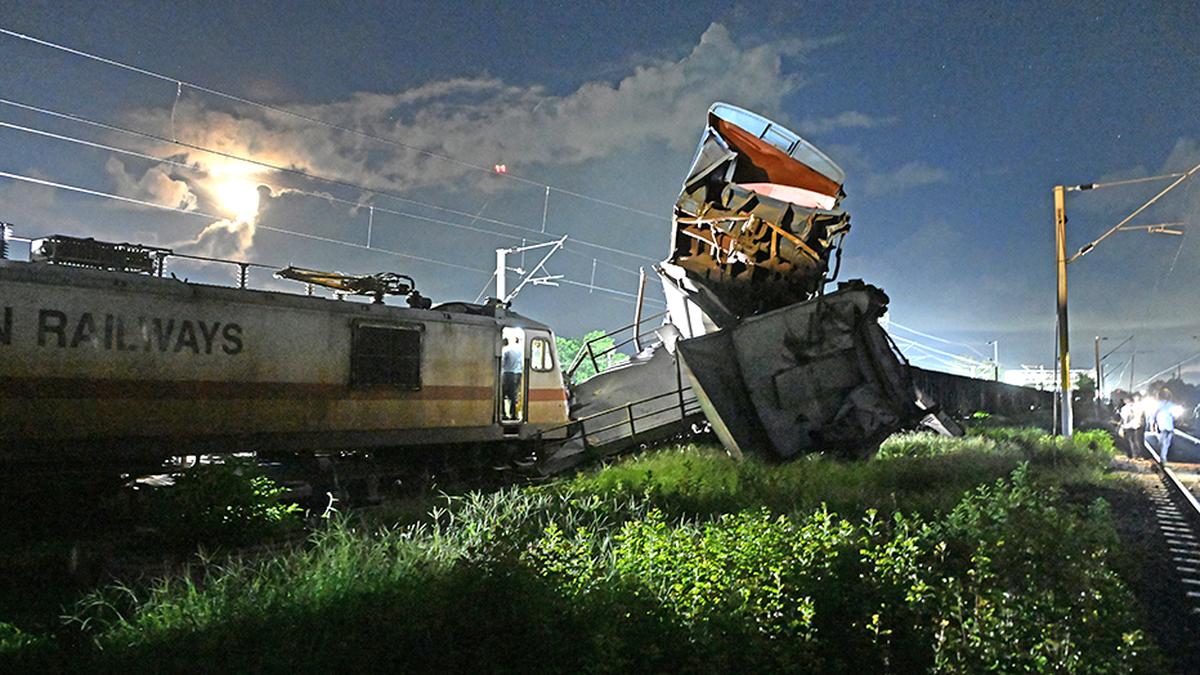What are the stress factors for Indian Railways?

- 22 Oct 2024
In News:
On October 17, eight coaches of the Agartala-Lokmanya Tilak Express derailed in Assam with no casualties. On October 11, a passenger train rear-ended a stationary goods train near Chennai, also with no casualties. Indian trains have been involved in multiple accidents of late. The Balasore accident on June 2, 2023, had the greatest death toll, more than 275, yet pressure on the Railways to improve safety competes with pressures straining its subsistence.
Railway Accident Trends
- Decline in Accidents Over Time:
- From 1,390 accidents per year in the 1960s, railway accidents have reduced to about 80 accidents per year in the last decade.
- Recent Consequential Accidents:
- 34 accidents in 2021-2022
- 48 accidents in 2022-2023
- 40 accidents in 2023-2024
- Primary Causes of Accidents:
- 55.8% due to staff errors (railway personnel).
- 28.4% due to non-staff errors.
- 6.2% due to equipment failure.
- Role of Signalling Failures:
- Major accidents, such as Balasore and Kavaraipettai, were attributed to signalling system failures.
Key Safety Technologies and Measures
- Kavach System:
- Kavach is an automatic train protection system designed to prevent collisions by monitoring train positions and activating alarms or braking.
- As of February 2024, Kavach was implemented on only 2% (1,465 route km) of the railway network, limiting its effectiveness.
- Signalling System Overhaul:
- Outdated and faulty signalling systems contribute significantly to accidents. Both Balasore and Kavaraipettai incidents were linked to failures in signalling infrastructure.
Financial Strain on Indian Railways
- Operating Ratio (OR):
- The Operating Ratio (OR) in 2024-2025 is estimated to be ?98.2, indicating that the Railways spends ?98.2 for every ?100 earned.
- A higher OR reduces available funds for safety improvements and infrastructure upgrades.
- Budgetary Constraints:
- The 2023-24 budget showed a 7.2% reduction in capital outlay for track renewal and a 96% decrease in the Depreciation Reserve Fund, which is used to replace aging assets.
- Revenue Imbalance:
- Freight services account for 65% of Railways’ revenue but face capacity constraints, with 30% of the network operating at over 100% capacity.
- Passenger services, however, continue to incur significant losses, with ?68,269 crore loss in 2021-22.
Challenges in Rail Infrastructure
- Slow Infrastructure Development:
- The government's Dedicated Freight Corridors (DFCs), intended to alleviate congestion, are severely delayed:
- The Eastern DFC is the only fully operational corridor.
- Other corridors, including the Western DFC and additional planned routes, remain incomplete.
- Track and Equipment Maintenance:
- Ongoing delays in upgrading and maintaining essential infrastructure (tracks, wagons, signalling) contribute to the rising number of accidents.
Loco Pilot Working Conditions
- Extended Working Hours:
- Loco pilots often work 12-hour shifts due to manpower shortages, leading to fatigue and increased risk of human error.
- Stress and exhaustion are significant contributors to accidents caused by human error, including Signal Passed at Danger (SPAD).
Recommendations for Improving Railway Safety
- Loco Pilot Vacancies:Immediate recruitment to fill the 18,799 vacant loco pilot positions to prevent overworking and reduce fatigue-related errors.
- Expand Kavach Deployment:Accelerate the nationwide installation of the Kavach system, particularly on high-risk and high-traffic routes, to enhance safety.
- Complete Dedicated Freight Corridors (DFCs):Expedite the completion of DFCs to ease congestion and increase freight movement efficiency.
- Independent Railway Safety Authority:Establish an independent Railway Safety Authority with statutory powers, as recommended by the Kakodkar Committee (2012), to enforce safety standards and monitor implementation.
- Improve Signal Infrastructure:Invest in advanced and reliable signalling systems to prevent errors stemming from outdated or malfunctioning infrastructure.
- Regulate Working Hours:Enforce strict work hour limits to reduce fatigue among railway staff and ensure proper rest between shifts.
- Strengthen Trackside Infrastructure:Install fencing along tracks in high-risk areas to prevent cattle run-overs, a common cause of derailments in rural and semi-urban areas.
Conclusion
- Indian Railways faces a complex set of challenges, balancing safety requirements with financial constraints. Despite technological advancements like Kavach, its limited deployment and outdated infrastructure continue to present significant risks.
- A holistic approach to reform is needed, including addressing manpower shortages, upgrading safety technologies, and investing in infrastructure development. This will be essential for reducing accidents, improving safety, and ensuring the long-term sustainability of India’s vast railway network.
